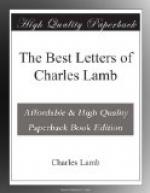Suggestions not unprofitable for these later days lurk in these traits of Elia the student and critic. How worthy the imitation, for instance, of those disciples who band together to treat a fine poem (of Browning, say, or Shelley) as they might a chapter in the Revelation,—speculating sagely upon the import of the seven seals and the horns of the great beast, instead of enjoying the obvious beauties of their author. To the schoolmaster—whose motto would seem too often to be the counsel of the irate old lady in Dickens, “Give him a meal of chaff!”—Charles Lamb’s critical methods are rich in suggestion. How many ingenuous boys, lads in the very flush and hey-day of appreciativeness of the epic virtues, have been parsed, declined, and conjugated into an utter detestation of the melodious names of Homer and Virgil! Better far for such victims had they, instead of aspiring to the vanities of a “classical education,” sat, like Keats, unlearnedly at the feet of quaint Chapman, or Dryden, or even of Mr. Pope.
Perhaps, by way of preparative to the reading of Charles Lamb’s letters, it will be well to run over once more the leading facts of his life. First let us glance at his outward appearance. Fortunately there are a number of capital pieces of verbal portraiture of Elia.
Referring to the year 1817, “Barry Cornwall” wrote:
“Persons who had been in the habit of traversing Covent Garden at that time of night, by extending their walk a few yards into Russell Street have noticed a small, spare man clothed in black, who went out every morning, and returned every afternoon as the hands of the clock moved toward certain hours. You could not mistake him. He was somewhat stiff in his manner, and almost clerical in dress, which indicated much wear. He had a long, melancholy face, with keen, penetrating eyes; and he walked with a short, resolute step citywards. He looked no one in the face for more than a moment, yet contrived to see everything as he went on. No one who ever studied the human features could pass him by without recollecting his countenance; it was full of sensibility, and it came upon you like new thought, which you could not help dwelling upon afterwards: it gave rise to meditation, and did you good. This small, half-clerical man was—Charles Lamb.”
His countenance is thus described by Thomas Hood:
“His was no common face, none of those willow-pattern ones which Nature turns out by thousands at her potteries, but more like a chance specimen of the Chinese ware,—one to the set; unique, antique, quaint, you might have sworn to it piecemeal,—a separate affidavit to each feature.”
Mrs. Charles Mathews, wife of the comedian, who met Lamb at a dinner, gives an amusing account of him:—




